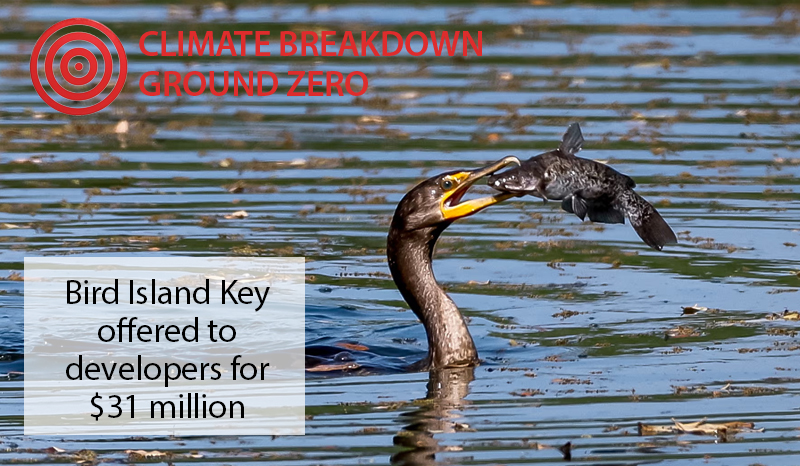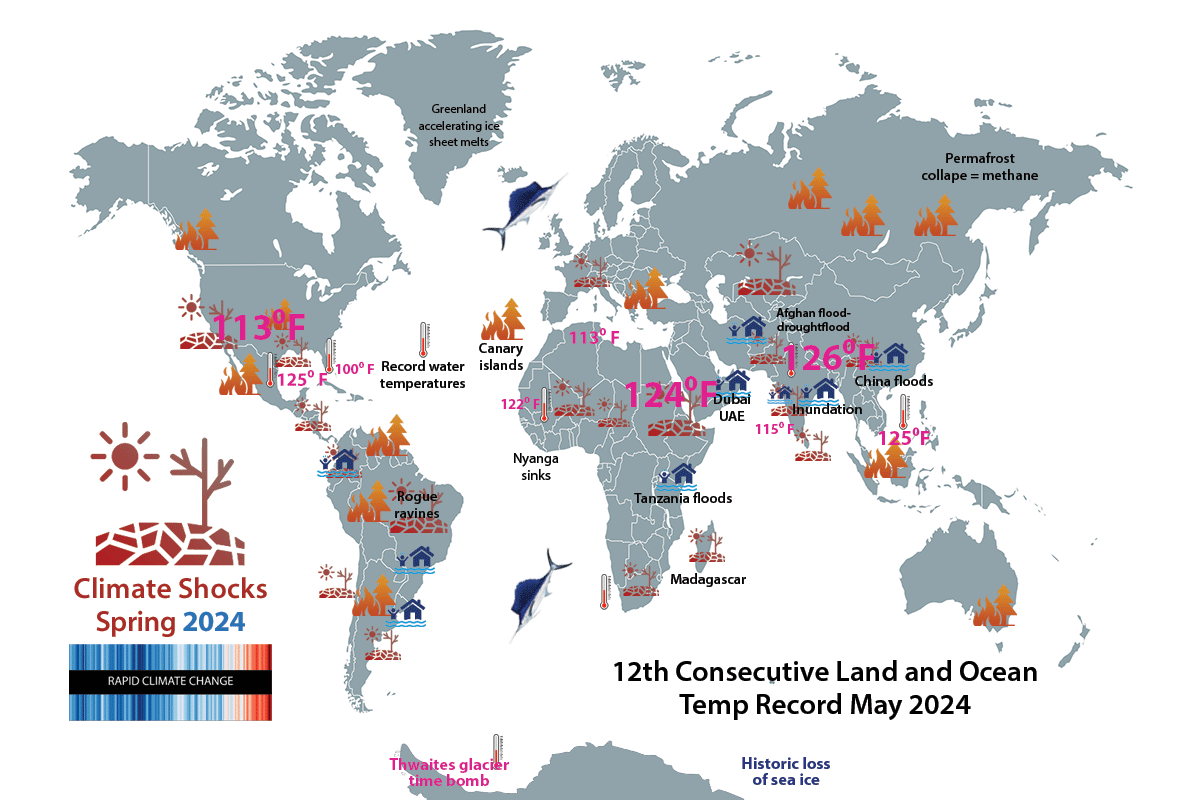
PLANET BREAKS 1400 HEAT RECORDS IN JUNE
April 2024 was the eleventh straight month to rock the planet’s global temperature record, as reported by the European Union’s Copernicus Climate Change Service. The average surface temperature of 57.45°F was 0.18 of a degree warmer than April 2016 (the previous hottest March). The measurements included both air and oceanic temperatures.
The past 13 months have been 1.68 C (3°F) warmer than pre-industrial levels, which means the sacred but arbitrary 1.5C (2.7°F) Paris accord benchmark agreed upon by lots of well meaning people has been breached. The reporting on this event includes a surprising number of statements to the effect that climate scientists are “scratching their heads.” That’s an Interesting turn of phrase, as if they can’t remember where they left their knitting.
Put simply, the planet has exceeded the consensus planetary safety metric considerably sooner than expected, although the condition would have to continue for a longer period before it becomes official. Nevertheless, there is no ignoring the parade of new reports confirming global warming is causing massive heat waves to crawl slower across the globe and they are baking more people for a longer time with higher temperatures over larger areas, a new study finds.
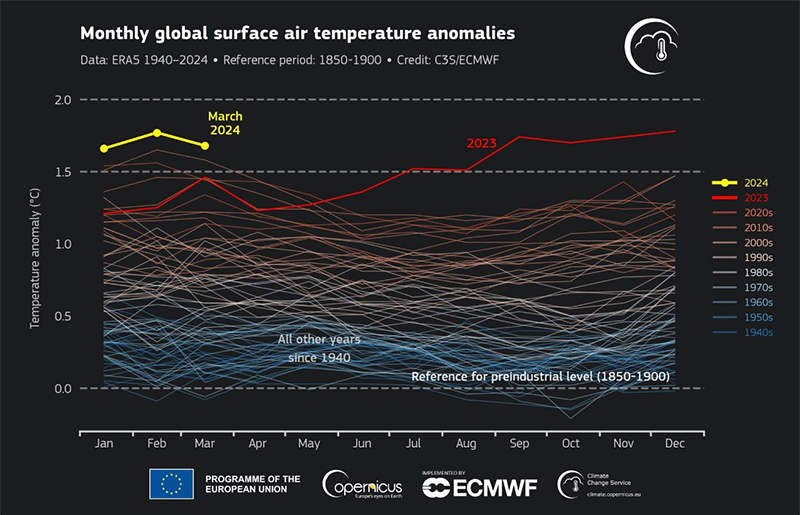
Longer and slower heat waves
Since 1979, global heat waves are moving 20% more slowly — meaning more people stay hot longer — and they are happening 67% more often, according to a study in Science Advances. The study found the highest temperatures in the heat waves are warmer than 40 years ago and the area under a heat dome is larger.
At present, climate scientists are regarding this unprecedented series of broken records as yet another indication that global warming is accelerating.
SCROLL DOWN FOR: New all time temp record for India | Mexico City running out of water | Egypt continues to break heat records | Bird Key sanctuary will be luxury condos | Miami breaks heat records as sea levels accelerate | Canadian fire season begins early as zombie fires come back to life | 300+ dead as mudslides and flooding sweep Afghanistan | Mexico heat wave kills dozens as hundreds of records fall | South Texas floods as region gets two ft of rain, more tornados | Brazil is rocked by more devastating floods | Climate change slows earth’s rotation as ice caps melt | Batagaika: Siberia’s Gateway to the Underworld expands | Last glacier in Venezuela disappears for good | Southeast Asia spring heat records bakes wide area | Global coral reef bleaching appears to be the worst yet | Midwest tornado attack | Howler monkeys are falling out trees, dead | Marine species are headed for the poles as oceans warm | Outer Banks beach home continue to collapse | Wildfires moving into Kansas
Welcome to the “Polycrisis” Spring 2024
Swiss floods and landslides kill dozens in extreme weather
Accumulating in the atmosphere even faster

1300+ dead Hajj pilgrims die in 120°F heat in Mecca
Stoning of the devil ritual might be a bad idea
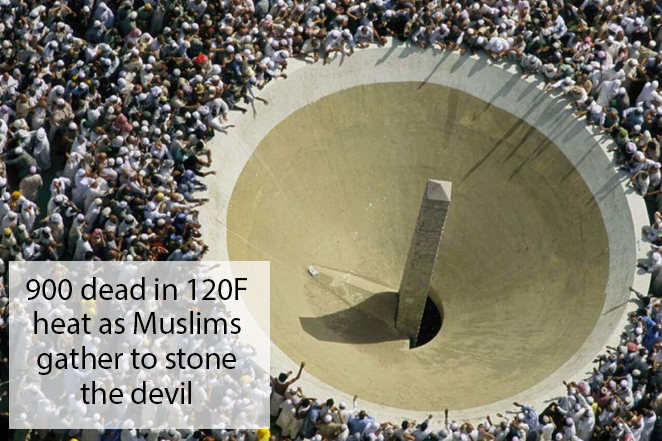
Dozens of people have died and thousands have been treated for heatstroke while performing the annual Muslim Hajj pilgrimage to Mecca amid extreme temperatures of up to 49 degrees Celsius (120 degrees Fahrenheit).
At least 41 Jordanians, 35 Tunisians and 11 Iranians are among the dead, according to authorities in each country. A further 22 Jordanians are missing and 26 Iranians have been hospitalized, the Iranian Red Crescent announced Wednesday, according to Iran’s semi-official Tasnim news agency.
Some of the Iranians died due to heatstroke while others had underlying conditions, the Iranian Red Crescent said.
The death toll is likely to rise, as Saudi Arabia and Egypt have yet to release official figures. Additionally, the governments are only aware of pilgrims who have registered and traveled to Mecca as part of their country’s quota – more deaths are feared among unregistered pilgrims..
Unusual Flooding in Spain’s Costa Blanca and Balearic Islands
Murcia receives more rain than normal summer
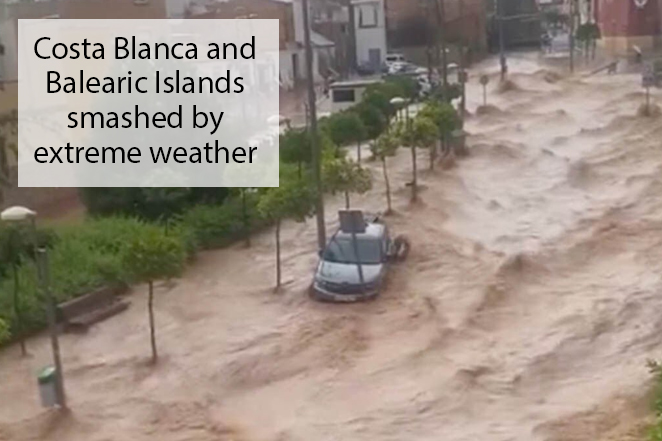
1200 evacuated in Los Angeles Post Fire
Accumulating in the atmosphere even faster
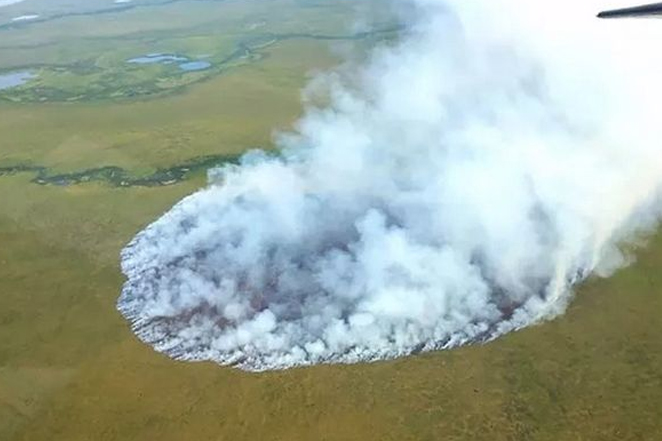
Houses and streets flooded as historic storms hit Moscow
Records fall in the region as death toll climbs
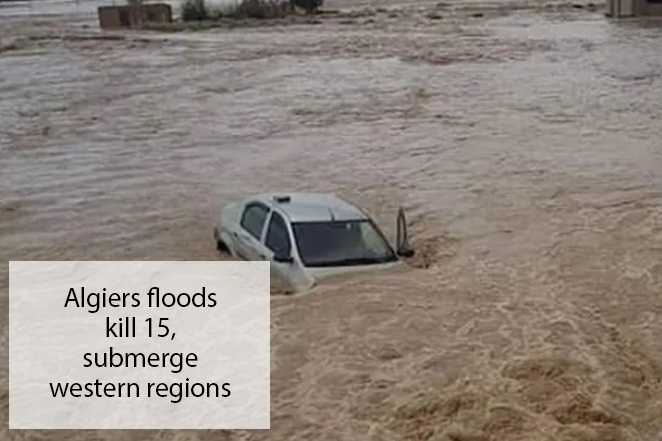
The heavy showers on Thursdaytriggered an “orange” weather warning for rain and “yellow” alert for thunderstorms.
Russian state media reported that almost a month’s worth of rain fell in some areas of Moscow in a few hours, citing the capital’s authorities.
Forecasters said that since the beginning of June, 162 per cent of monthly precipitation had already fallen in Moscow.
he Russian news website Mashreported people “floating along multi-storey buildings on Klyazminskaya Street” north of the city.
“Cars are drifting nearby, the storm drain can’t cope with the volume of water. The street is blocked,” the media outlet said, adding that residents in the nearby Dmitrovsky Park apartment complex reported flooding in the underground car park.
It comes after the south-western city of Orenburg, near Russia’s border with Kazakhstan, was hit by extreme flooding in April, the worst seen since 1942, according to reports.
The floods submerged nearly 18,000 homes in the region, Russia’s Tassnews agency reported, with Kurgan and Orenburg hit the hardest
New Mexico fires combine with catastrophic rains
Heat waves more intense and frequent
Egypt is not known as a temperate region, but the instances of extreme, sustained heat waves are increasing. In June, the southern city of Aswan broke its all high temperature record with a reading of 123.6°F (50.9°C).
As is the case with most climate related events, the root causes of Egypt’s heat records are complex. In addition to rising global temperatures, the Nile region’s troubles are also caused by changes in land use and urbanization.
China north bakes while deadly floods and landslides hit the south
Accumulating in the atmosphere even faster
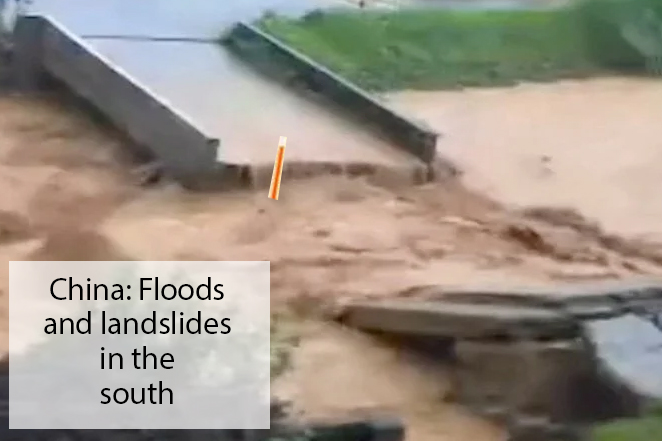
Miami sees another 200 year flood after “just another storm”
Don’t y’all dare say “climate crisis.”

About a foot and a half of water had fallen across South Florida—not the product of a hurricane or a tropical storm but of a rainstorm, dubbed Invest 90L, a deluge that meteorologists are calling a once-in-200-years event. It was the fourth such massive rainfall to smite southeastern Florida in as many years..
The man who stole your water is Saudi Arabia
Heat waves more intense and frequent
Egypt is not known as a temperate region, but the instances of extreme, sustained heat waves are increasing. In June, the southern city of Aswan broke its all high temperature record with a reading of 123.6°F (50.9°C).
As is the case with most climate related events, the root causes of Egypt’s heat records are complex. In addition to rising global temperatures, the Nile region’s troubles are also caused by changes in land use and urbanization.
Atmospheric CO2
levels continue to climb in 2024
Accumulating in the atmosphere even faster

Lethal Algerian flash floods take western regions by surprise
Records fall in the region as death toll climbs

It may be surprising to see a nation as arid as Algeria (about 80% desert in sq. miles. What that means, however, is that it is more prone to rapid flooding when the storms do flood, the hard ground is unable to absorb the water. When combined with rapid urbanization and bad stormwater infrastructure, the region can be quickly overwhelmed. Fifteen deaths have been reported. Farmlands were submerged, threatening livestock and agricultural areas.
Algeria has been hit by a successive series of major floods in the first half of the year. The emerging drought flood drought pattern is similar to other nations on the leading edge of the climate crisis.
Egypt blasts through another all time temperature record at 124°F
Heat waves more intense and frequent
Egypt is not known as a temperate region, but the instances of extreme, sustained heat waves are increasing. In June, the southern city of Aswan broke its all high temperature record with a reading of 123.6°F (50.9°C).
As is the case with most climate related events, the root causes of Egypt’s heat records are complex. In addition to rising global temperatures, the Nile region’s troubles are also caused by changes in land use and urbanization.
Panama evacuates a small island in another climate refugee saga
Gardi Subdub one of 60 to be evacuated
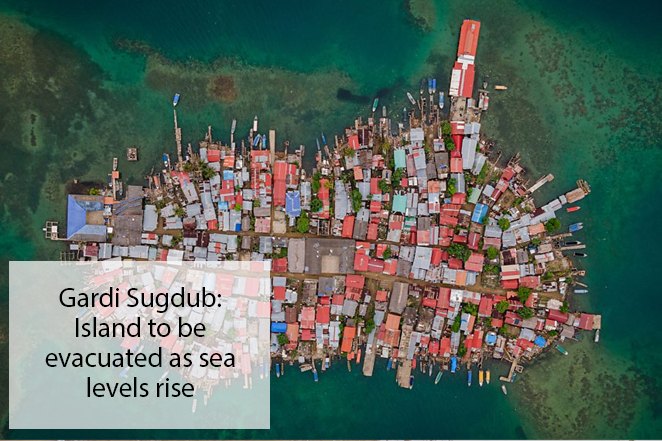
Phoenix moves into lethal heat territory yet more people come
Vegas also hit new record at 113°F
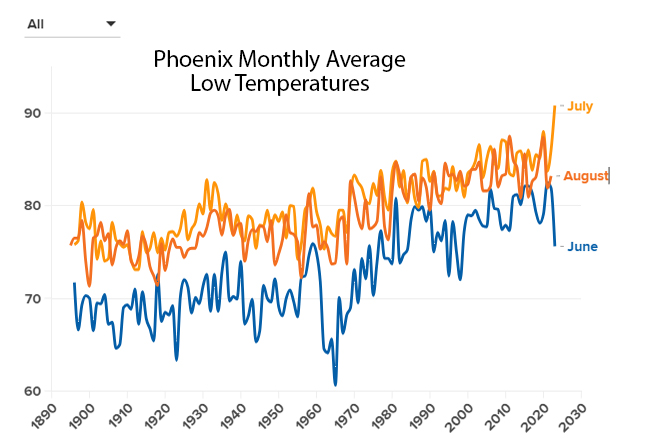
Average summer temperatures in Phoenix increased 2.9°F between 1970 and 2022, yet more Americans migrate to Arizona’s capital. As a result, heat related deaths are increasing.
Excessive heat warnings have been issued as high temperatures exceeding 113°F in early June. A new record was set on June Arizona is not known as a temperature climate, but conditions are changing rapidly. The less publicized but potentially more harmful stat of overnight low temps is increasing even more quickly. What this means is that the environment doesn’t cool off, which seriously disrupts animals and plants.
German flooding turns deadly as thousands evacuate
Four dead in early reporting as shipping stalls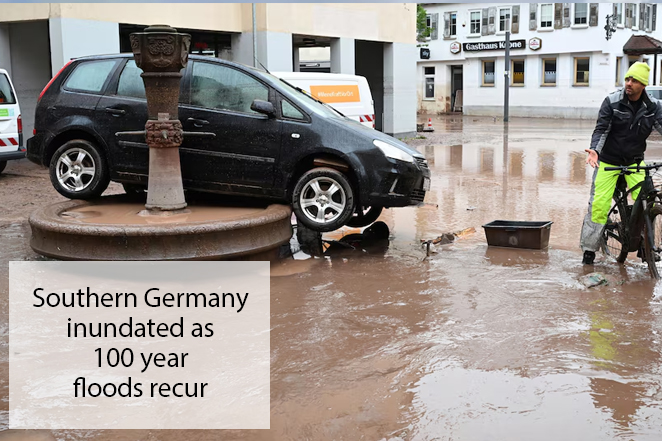
June in southern Germany began with severe storms that caused flooding across the southern states of Baden-Württemberg and Bavaria. The rail link between Stuttgart and Augsburg was closed due to the severe weather and one high speed train was derailed.
All shipping was suspended in the area from the upper Rhine, according to Germany’s waterways and shipping office.
Four people have been reported dead.
.
Another North Carolina beach home takes a dive
“Another one bit the dust…”
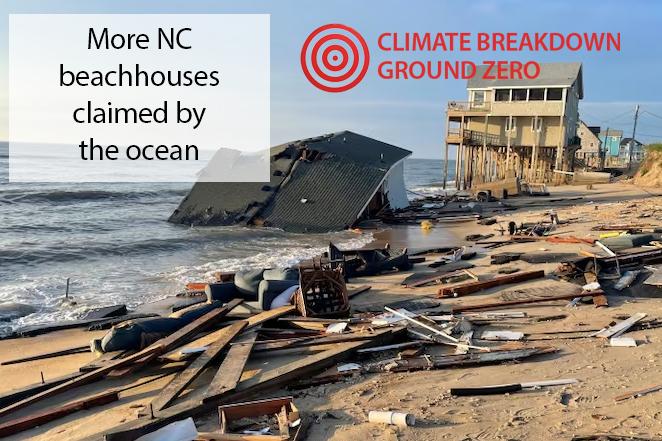
India blows through national temperature record at 126°F
Records fall in the region as death toll climbs
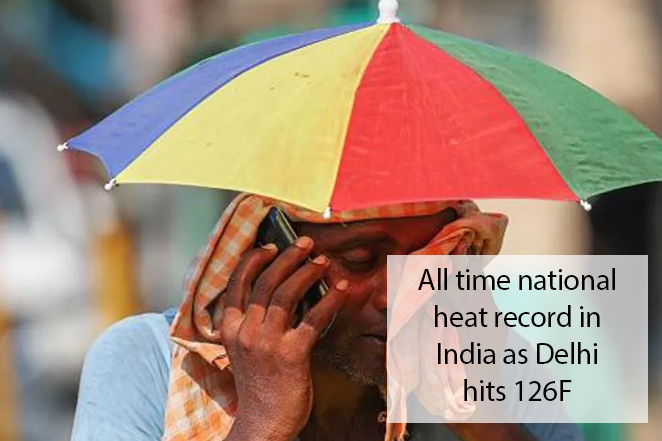
Courts, schools and government offices were closed in late May after the country broke its time high temperature record of 126° F (52.3C) registered in Delhi. More than 37 cities in the country reported temperatures over 113° F.
Initial heat related deaths were in the dozens but expected to climb. Meanwhile, forest fires are reported as the heat wave continues and foliage dries out.
The ongoing regional water crisis was worsened by the heat wave, exacerbated by wanton waste of water by the wealthy.
Kansas Wildfires making Dorothy consider staying in Oz
“Let’s get out of here Todo”
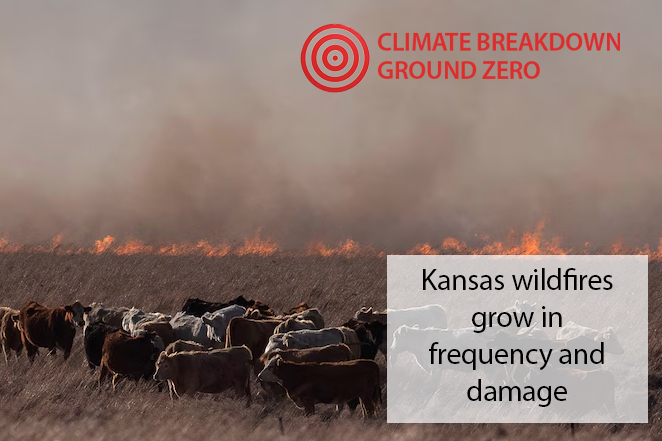
The Kansas Forest Service has announced that the home of the “south wind people” is facing significantly elevated risks of wildfire as the climate heats up. As is the case in the US mountain west, they no longer burn only during the summer.
As a harbinger of things to come, the Four County Fire burned more than 120,000 acres in 2021 and the Starbuck Fire fired thousands of cattle and torched 2 million acres.
in general, global warming is driving fire east, as fires begin earlier in the season and burn into winter. As a result, more states face a growing danger to people and property.
Midwest tornado onslaught driven by heat and moisture
Greenfield laid waste, 250 ft turbines toppled and Grandma Dixie buried alive*
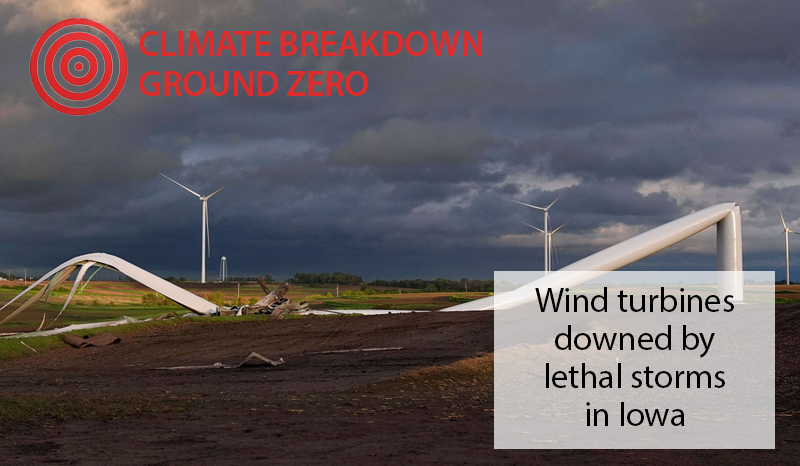
Several tornadoes ripped a swath of destruction across Iowa leaving several people dead before tearing into parts of Illinois and Wisconsin. Four deaths have been reported and much of the town was laid waste.
“There is basically nothing left,” said Clel Baudler, a former Iowa state representative who lives a half mile from Greenfield.
*she lived.
Passenger death makes avoiding clear air turbulence topic trickier
Plane drops 4,000 ft in 3 minutes

There is a point where news media has to report incidents as dramatic as this extreme turbulence episode in Asia. One passenger died and 30 others were injured aboard a Singapore Airlines flight that was hit by “severe turbulence,” officials said Tuesday, but experts say such deaths are rare even as researchers warn climate change may be causing more extreme cases of turbulence.
Since 2009, the National Transportation Safety Board said, the U.S. has not had any turbulence-related deaths aboard large commercial planes, such as the Boeing aircraft that encountered sudden extreme turbulence over the Irrawaddy River in Myanmar at 37,000 feet.
A 73-year-old passenger who had some medical problems died, possibly from cardiac arrest, and at least seven people were critically injured, Kittipong Kittikachorn, general manager of Bangkok’s Suvarnabhumi Airport, said at a news conference Tuesday.
Mexico heatwave causing howler monkeys to fall dead from trees
“Falling out the trees life apples…”

How hot is it? It’s so hot in Mexico that howler monkeys are falling dead from the trees.
Howler monkeys live in the steamy jungles of the Mexican Tabasco state and are uniquely adapted to their habitat. So when it stays this hot this long that they begin dying of dehydration, something is very wrong. Since early May, officials in Mexico have counted hundreds of monkeys lying dead on the ground beneath the trees.
“They were falling out of the trees like apples,” Pozo said. “They were in a state of severe dehydration, and they died within a matter of minutes.”
The monkey mortality event has multiple causes, including heat, drought, forest fires and logging that deprives the monkeys of water, shade and the fruit they eat.
Temperatures in the region have reached 113°F.
Mexico City runs out of water for regular people
City of 25 million in deep trouble
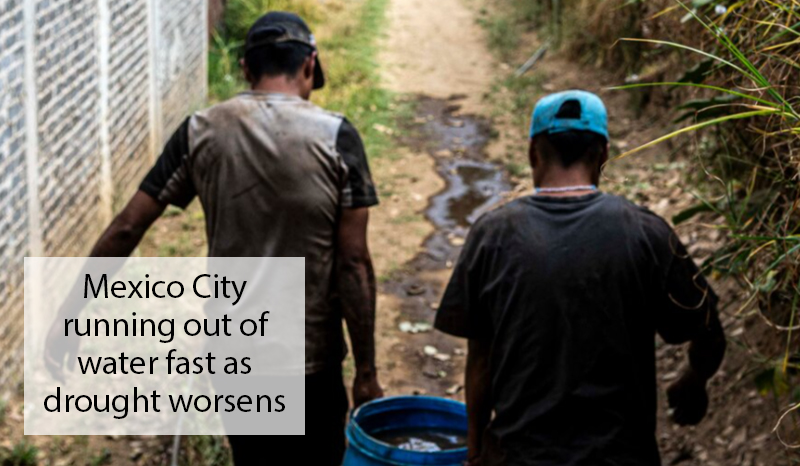
Mexico City is truly one of the planet’s megacities, urban nightmares so sprawling that the population can’t be counted accurately. It is estimate at around 25 million, about twice the size as New York City.
Unfortunately, the city is on the brink of a rolling disaster as groundwater disappears. One key reservoir no longer supplies water and the main water system is looking at a potential Day Zero coming up this summer. The immense Cutzamala water system is at a historically low 30 percent of its normal capacity. At the current rate, groundwater is pumped twice as fast as it is replenished
The cause of the crisis is unrelenting heat and lack of rainfall, combined with runaway population and terrible infrastructure management.
Other megacities facing severe water shortages are Cape Town; São Paulo and Chennai, India.
Bye Bye birdies: Bird Key nesting island for sale
Birds vs greed: the birds lose every time
Business as usual in Florida as a historic seabird preserve goes on the block, as “a golden opportunity for a developer.” Originally purchased as a private island for the purpose of saving it, the lure of big bucks was too much for the owner to resist.
“Miami’s most exclusive address”
Owner Finlay Matheson, who bought the small island for $36,000 in the 90’s and now expects to cash in for $31.5m. Promotional material describes the undeveloped key as “Miami’s most exclusive address.”
One of two natural islands in upper Biscayne Bay, Bird Key unspoiled nesting sanctuary since then to scores of species of native birds, including egrets, cormorants, herons and pelicans.
Sea levels are rising ever faster as Miami smashes May records
How much longer will S. Florida be viable?
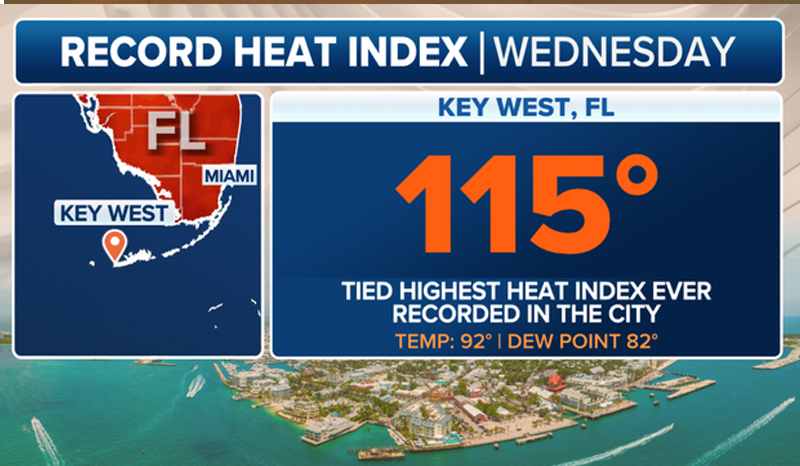
As Miami and South Florida bake under record May heat, the National Oceanic and Atmospheric Administration (NOAA) reports that sea level rise is increasing at an accelerating rate.
Several records have been tied or broken across South Florida including Key West, which tied its highest heat index at a 115° F degrees and broke it’s “real” temperature record at 96° F,
“The oceans are running hot and they’re running high,” NOAA Oceanographer Dr. William Sweet said. “We’re melting more land-based ice out of Antarctica and Greenland and mountain glaciers, and the ocean is heating, especially in the Gulf of Mexico and the Southern Atlantic.
Sea level rise has increased about a foot in the last 80 years, with 8 in. of that coming in the last 30. The next ft. of inundation may take only 20 years. And NOAA reports that that rate is increasing quickly.
It took about 80 years for the first foot. The second one will only take 30 years. The next, 20 years. And Florida could see the next foot in merely a decade after that.
Gov. Ron DeSantis signed a new law banning references to “climate change” in Florida state statutes – and also banned lab grown meat.
Evacuation orders in BC as fire season resurges
Zombie fires coming back to life
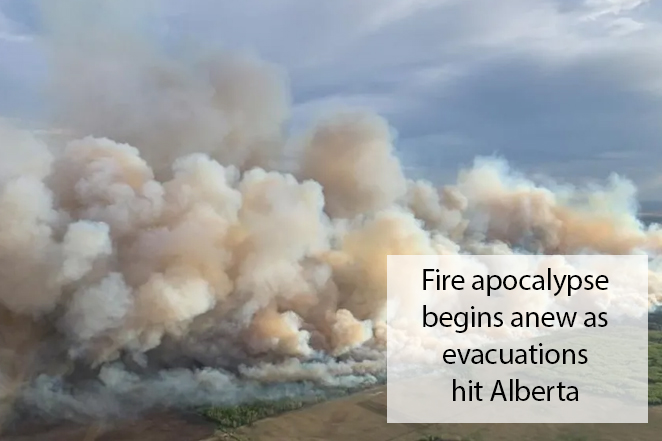
During Canada’s warmest ever winter, Zombie fires continued to burn, the drought dragged on and the snow didn’t come.. Now the disaster’s of last summer seem doomed to repeat themselves as evacuation orders were issued to thousands in Mid-May in British Columbia and Alberta amidst a resurgence of wildfires. The government ordered thousands to leave Fort Nelson, BC as a resurgent zombie blaze threatened the town. A zombie fire means it smoldered over the winter and was never extinguished.
Forty of the wildfires were listed as out of control on the 13th of May. In a repeat of last year’s apocalyptic smoke issues, Minnesota is reporting air quality issues 2,000 miles away.
The province of Alberta is now in Stage Four of its five-stage water shortage management response plan.
300+ dead as mudslides and flooding sweep Afghanistan
“this is a major humanitarian emergency”

Hundreds are dead, thousands are missing and nearly 3000 homes have been swept away as catastrophic flooding sent roaring rivers of water and mud crashing through villages and agricultural fields. Many areas are cut off from rescue and emergency services. Authorities are calling it a “major humanitarian emergency”.
“My house and my whole life was swept away by the flood. There was nothing left, all my belongings and my house had been destroyed. I don’t know where to take my family … I don’t know what to do.”
Ironically, Afghanistan is also in the midst of a prolonged drought that means near famine conditions for a million children.
Mexico heat wave kills dozens as hundreds of records fall
Sensación térmica reaches 125°F
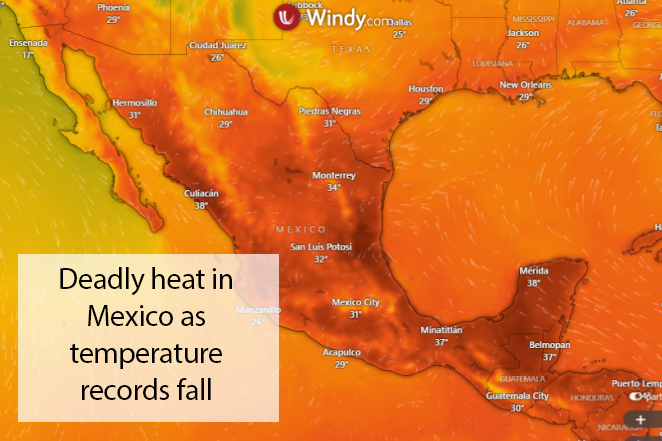
in 2024, almost 44.8% of homes in the United States (about $22.0 trillion) are threatened by at least one extreme climate risk from either flood, wind, wildfire, heat or air quality
Texas floods as region gets two ft of rain, more tornados
Lethal storms and floods continue
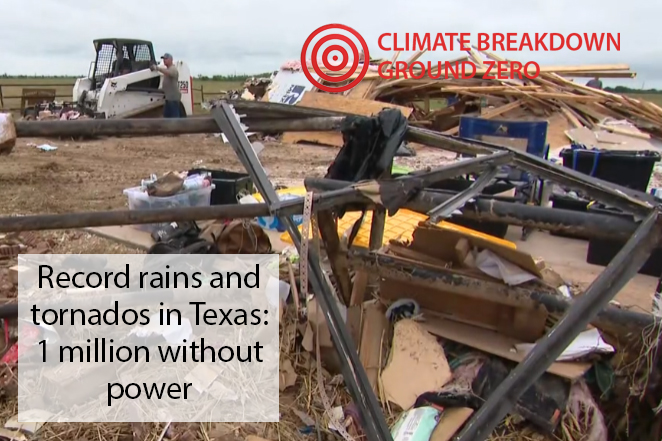
At lease one child is dead and millions are without power as floods swept through Southeast Texas, wrecking homes, roads and other infrastructure. . More than 400 people were evacuated and eight million people were under flood alert as standing water reached two feet high. High waters reached the roofs of some homes. Hundreds of structures are flooded, and more are dealing with power outages.
Like much of the world, Houston’s 100 year old city infrastructure is not adequate for the new normal of extreme storms and relentless rains.
Brazilian state is rocked by more devastating floods
Death toll exceeds 200 as rains continue
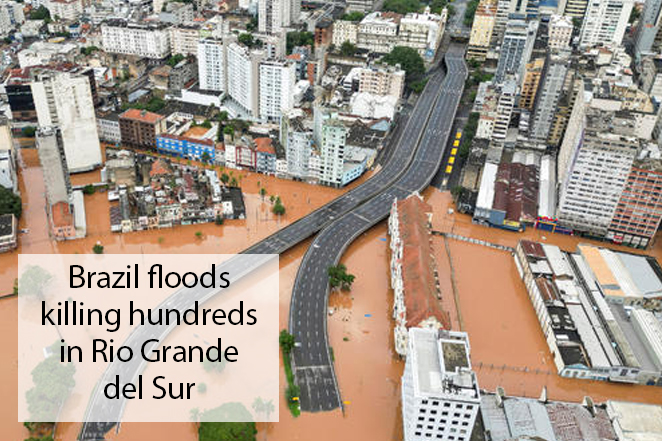
Hundreds of people have died and 25,000 are homeless as massive flooding and landslides swept through southern Brazil’s Rio Grande do Sul state. More are missing. The ongoing disaster was triggered by unrelenting storms driven by a week of high temperatures and humidity and powerful winds.
The cities of Canoas and Eldorado do Sul are facing a catastrophic situation with 200,000 displaced. Among the cascading disasters was the partial collapse of a hydroelectric dam, resulting in a 7 ft. high wave downstream.
“This is the worst disaster ever registered in the state of Rio Grande do Sul. Perhaps one of the worst disasters that the country has registered in recent history.” said Gov. Eduardo Leite.
Of course, this is the same governor who rolled back large numbers of environmental regulations as his first move in office.
Climate change slows earth’s rotation as ice caps melt
Scientific America: mass redistribution
 Earth’s rotation is slowing imperceptibly as rising global temperatures melt the polar ice sheets. The shifting water volume is creating such a huge redistribution of the planet’s mass that its rotation speed is dropping.
Earth’s rotation is slowing imperceptibly as rising global temperatures melt the polar ice sheets. The shifting water volume is creating such a huge redistribution of the planet’s mass that its rotation speed is dropping.
The ice sheets that cover Greenland and Antarctica are several miles thick, enough mass to exert a strong gravitational pull on the oceans. The global weight redistribution of is actually slowing Earth’s rotation minutely, which may result in the elimination of a “leap second” later this decade.
Greenland Is Shedding 33 Million
Tons of Ice… Per Hour
Quoted in Scientific American, Geophysicist Duncan Agnew said: “This is another one of those ‘this has never happened before’ things that we’re seeing from global warming: the idea that this effect is large enough to change the rotation of the entire Earth.” Duncan is co-author of the research just reported by the Scripps Institution of Oceanography.
Batagaika: Siberia’s Gateway to the Underworld expands
The permafrost chasm digesting Russia
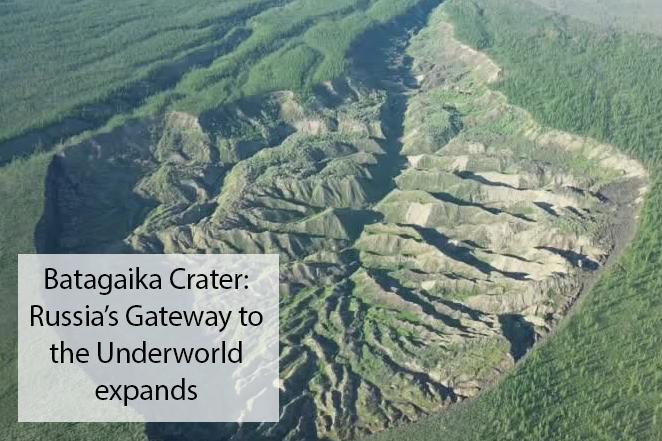
The Batagaika crater megaslump is a massive, expanding chasm in the Russian boreal forest that is something of a poster child for the crazy things going on in the far north. This and other rifts appear as the ground buckles and slumps into permafrost weakened by rapid thawing. Also known as a thermokarst depression, the crater is accelerating its expansion, widening about 40 – 60 feet per year and about a million cubic meters of volume. It is about 330 ft. deep and 2,500 feet wide at this point.
The indirect cause is global warming, which is thawing permafrost very quickly in Siberia, Alaska and Canada. Crumbling permafrost has already been messing with cities and industrial infrastructure in Russia, crumbling roadways and (ironically) disrupting pipelines. New craters are also exploding to life in the Arctic oceans, releasing methane stores.
The Arctic is warming at least 2.5 times faster than the rest of the world.
The Gateway to the Underworld is not the same as the Gates of Hell, a burning crater in Turkmenistan. Read more here.
“The most significant climate event in history.”
Continuation of climate driven disasters

Hundreds of people have died and 25,000 are homeless as massive flooding and landslides swept through southern Brazil’s Rio Grande do Sul state. More are missing. The ongoing disaster was triggered by unrelenting storms driven by a week of high temperatures and humidity and powerful winds.
The cities of Canoas and Eldorado do Sul are facing a catastrophic situation with 200,000 displaced. Among the cascading disasters was the partial collapse of a hydroelectric dam, driving a that resulted in a 7 ft. high wave downstream.
“This is the worst disaster ever registered in the state of Rio Grande do Sul. Perhaps one of the worst disasters that the country has registered in recent history.” said Gov. Eduardo Leite.
Of course, this is the same governor that rolled back large numbers of environmental regulations as his first move in office.
Last glacier in Venezuela disappears for good
Humboldt glacier melts faster than expected
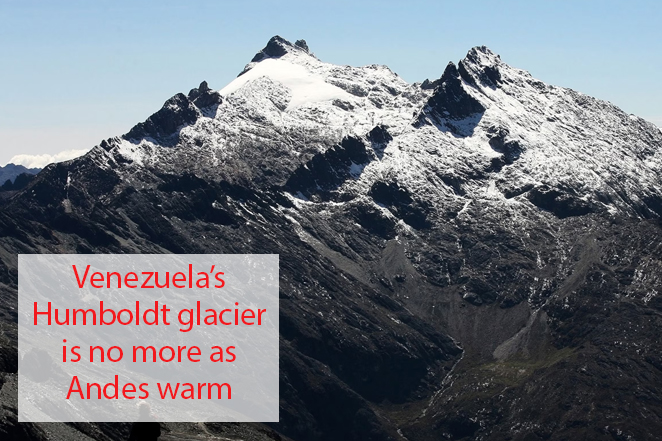
Venezuela became the first nation to lose all of its glaciers as the Humboldt glacier dwindled to a two hectare ice field. has lost its last remaining glacier after it shrunk so much that scientists reclassified it as an ice field. The glacier melted much faster than originally projected.
Within the 21st Century, the politically unstable nation has lost all six glaciers in the Sierra Nevada de Mérida, which is about 3 miles high. With five gone by 2011 the Humboldt was the last remaining.
Indonesia, Mexico and Slovenia are predicted to be the next to lose all of their glaciers..
Venezuela is a harbinger of the progression of glacier collapse in South America as heat waves move into Colombia, Ecuador, Peru and Bolivia in the Andes..
“This is another one of those ‘this has never happened before’ things that we’re seeing from global warming: the idea that this effect is large enough to change the rotation of the entire Earth.”
March of the sudden gullies alarms South America
Joining exploding methane craters in the Arctic
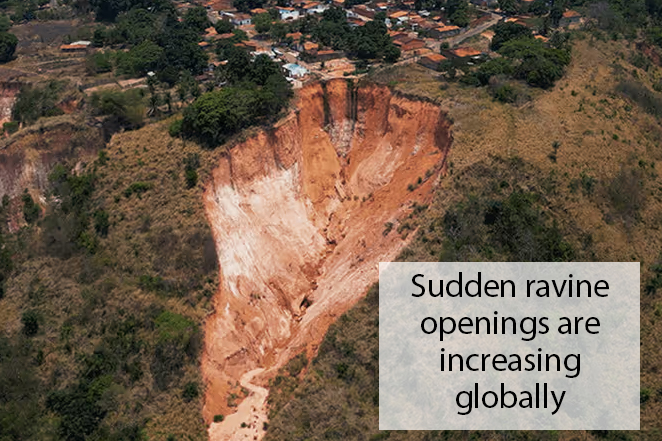 Ravines and gullies are cracking open suddenly in Brazil and other regions of South America, swallowing whole neighborhoods along with thousands of homes. Some of the rogue ravines are 200 ft. deep.
Ravines and gullies are cracking open suddenly in Brazil and other regions of South America, swallowing whole neighborhoods along with thousands of homes. Some of the rogue ravines are 200 ft. deep.
While this is not a new phenomenon, the events appear to be increasing in area due to a range of causes. Deforestation plays a big part in this type of soil degradation. with timber companies leaving behind rapidly eroding wastelands. Cutting down forests creates another feedback cycle, as the local climate becomes more sporadic, storms become more extreme and last longer.
The advance of rogue ravines may be thought of as the tropical version of permafrost thaw, which results in rapid subsidence and even exploding craters as methane is released from beneath the once frozen earth.
Southeast Asia spring heat breaks records in wide area
Early heatwave could be bad news for summer
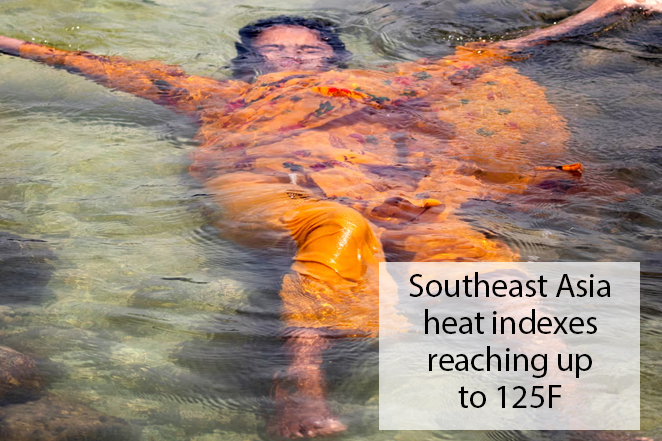 Thailand, the Philippines and much of the rest of Southeast Asia is coping with a weekslong heat wave in May record-high temperatures led to school closings in several countries and urgent health warnings throughout the region..
Thailand, the Philippines and much of the rest of Southeast Asia is coping with a weekslong heat wave in May record-high temperatures led to school closings in several countries and urgent health warnings throughout the region..
“Thousands of records are being brutalized all over Asia, which is by far the most extreme event in world climatic history,”
- weather historian Maximiliano Herrera in X post.
..
4th global coral bleaching event endangers a critical lifeform
Ongoing disaster is seen as the worst yet
 Extreme ocean temperatures are driving the latest planet wide surge in coral bleaching (another way to describe dying coral reefs). According to NOAA, the disaster is far more than a matter of underwater tourist inconvenience: the coral ecosystem is the epicenter of food, jobs and coastal security. Coral is one of the most sensitive marine lifeforms to heat. Coral bleaching reduces the reproductivity of corals and makes them more vulnerable to fatal diseases. If the bleaching is not too severe, corals have been known to recover.
Extreme ocean temperatures are driving the latest planet wide surge in coral bleaching (another way to describe dying coral reefs). According to NOAA, the disaster is far more than a matter of underwater tourist inconvenience: the coral ecosystem is the epicenter of food, jobs and coastal security. Coral is one of the most sensitive marine lifeforms to heat. Coral bleaching reduces the reproductivity of corals and makes them more vulnerable to fatal diseases. If the bleaching is not too severe, corals have been known to recover.
Since mid-March 2023, the average sea surface temperature (SST) has been abnormally high. In March this year, it reached a record monthly high of 21.07 degree Celsius, according to the EU Copernicus Climate Change Service (C3S). Nearly 90% of the extra heat trapped by GHGs has been absorbed by the oceans — that is why they have become so warm. The oceans are also absorbing CO2, causing ocean chemistry to acidify.
Coral reefs, also referred to as “rainforests of the sea”, have existed on the Earth for nearly 450 million years. Australia’s Great Barrier Reef is the largest in the world, stretching across 2,028 km.
Heat wave, drought in Western Africa as heat indexes hit 140°F
Worst in hundreds of years
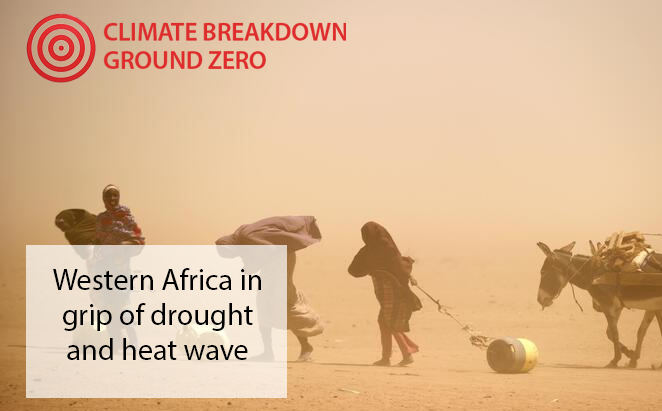
In March and April 2024, days and nights of extreme temperatures have afflicted western Africa nations, with heat indexes reaching above 140°F. Temperatures in Mali and Burkina Faso were high enough to be labeled a 200 year event by World Weather Attribution (WWA).
Florida GOP legislature cancels crisis by banning climate change
One of the most vulnerable states solves it

More on this story here.
..
Historic rains flood Dubai, UAE in sudden flooding event
Are you ready for Rain Enhancement Science?
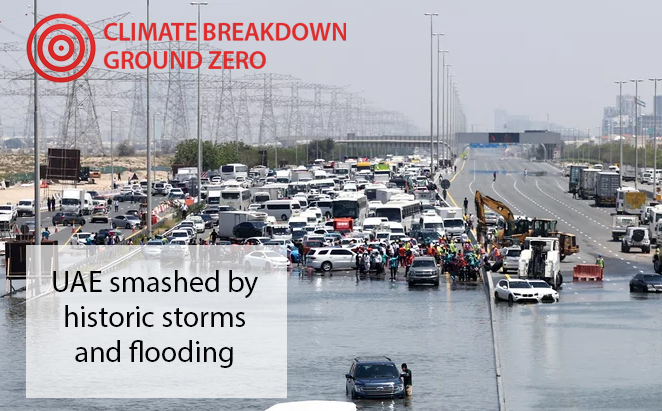
More on this story here.
Wildfire season begins early in British Columbia
Zombie fires coming back to life
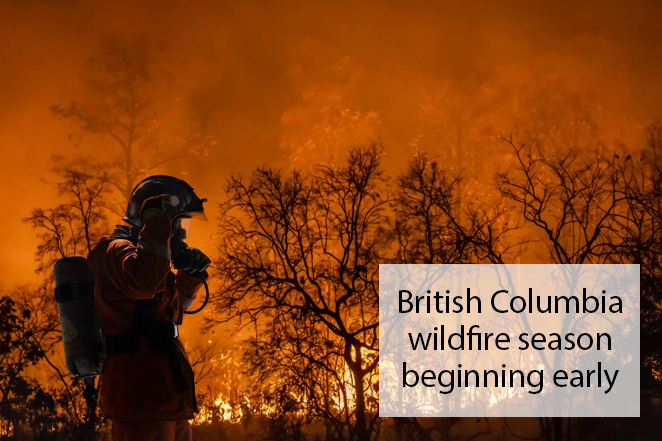
It appears that Canada’s fire season is starting early as “zombie” fires from last year’s disaster began reigniting in February. The first evacuation alerts were on April 21.
According to the BC Wildfire Service, there are currently more than 115 active wildfires burning across the province, some listed as out of control.
The northeast region of the province in particular has been in serious drought for three years. Last year’s wildfire season was the province’s worst on record with 2.8 million hectares destroyed, double any previous year.
.
Nyangai, Sierra Leone Atlantic island almost gone
Abandoned in one decade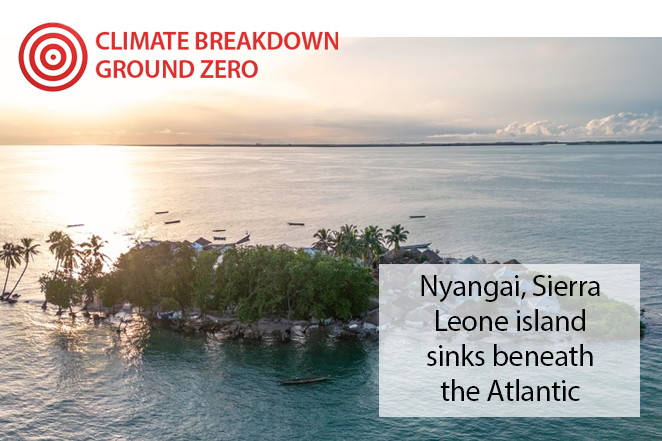
A tropical island off the Atlantic Coast of Sierra Leonne is pretty well gone beneath the rising seas. From 500 homes only a decade ago, the number of habitations on Nyanga, Sierra Leone has now shrunk fewer than 100. The once lush paradise – which measured about 2,300 ft. from one end to to the other as recently as ten years ago – is now only a few hundred ft. on any side.
The relentless incursion of saltwater over the past decade has destroyed the forests and most of the public places are now under water most of the time. While low lying islands have always been in flux, the speed of this transformation is unprecedented.
“The water is destroying us one house at a time.”
Fisherman Kpana Charli, quoted in NPR
Fish moving toward the poles as ocean waters warm quickly
Fish and marine species can’t take the heat

A new study at Tel Aviv University has reconfirmed that hundreds of marine species are migrating rapidly toward both poles as the global ocean temperatures continue to set records.
This epochal change is not only of interest to global fisheries, it also validates reports of significant declines in population abundance.
Compounding the issue of warming is ocean acidification, a direct result of ocean waters absorbing increased levels of carbon dioxide from the atmosphere.
This chemical change in seawater can have harmful and in some cases cause existential threats to marine life, especially species like shellfish and corals. Clams, oysters, and sea urchins rely on calcium carbonate to build their shells, so changes can disrupt early growth. Larger animals like fish that feed upon shellfish may experience food shortages.
Warming of Antarctica’s deep waters causing sea-level rise
Global circulation slows ocean currents
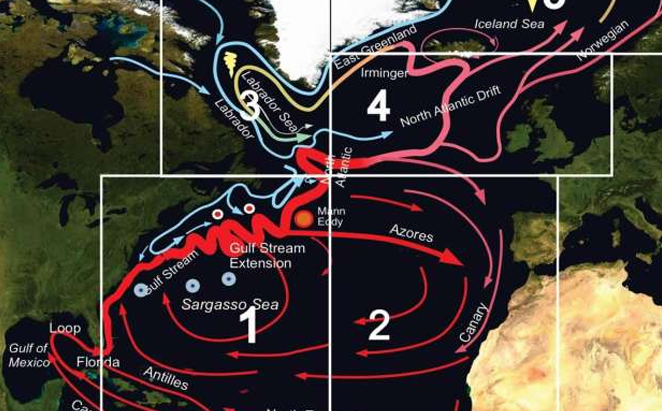
According to researchers at the University of Miami and NOAA’s Atlantic Oceanographic and Meteorological Laboratory, Antarctica’s deep waters are warming alarmingly last, exacerbating the powerful trend toward North Atlanta sea level rise.
The study also reflects the results of other research about the Atlantic Meridional Overturning Circulation (AMOC). which has weakened by around 12 percent. As a result, deeper waters in the Southern Ocean are warming, which in turn speeds up sea-level rise in the North Atlantic.
The AMOC balances global temperature systems by flowing warm water to the North and cold water to the South. This current is critical for the maintenance the European status quo that keeps much of northern Europe temperate.
Kenya, Tanzania, Burundi storms continue for weeks, kill hundreds
Rainforest exploitation and global warming
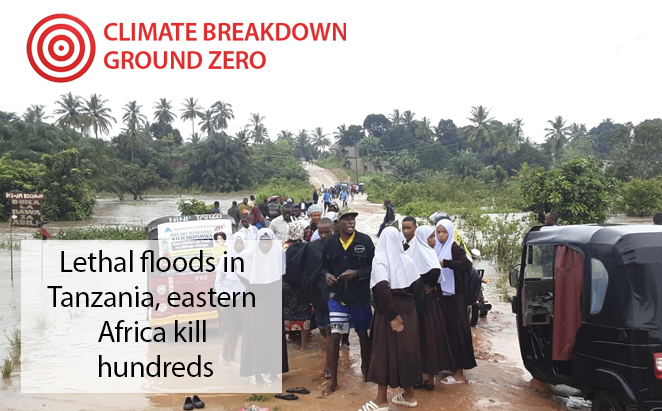
Kenya’s flood toll rises to 181 and 190,000 residents have been driven from their homes as rising waters continue to sweep away houses and roads.
Further south, flooding in Tanzania and a larger swath of eastern Africa caused by weeks of heavy rain has killed 155 people and chased more than 200,000 others from their homes and fields. The storms crossing the region have been increasing over the past two weeks, amplifying the normal rainy season. More than 51,000 households have been affected by the rains.
Sri Lanka drought flood drought forms dangerous new normal
Extreme weather impacting agriculture
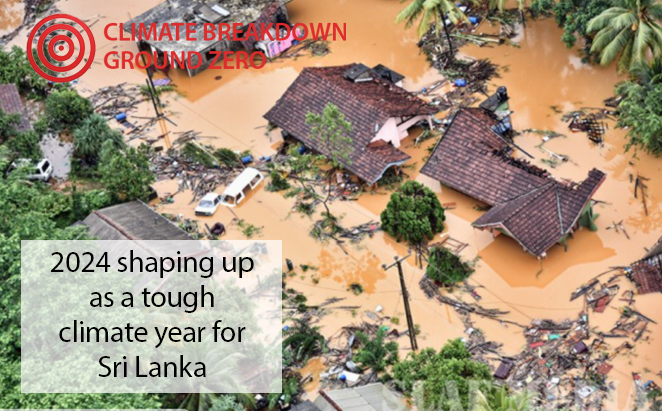
As the climate of the Bay of Bengal region changes precipitously, the island of Sri Lanka’s in particular is experiencing devastating weather disruptions, alternating between droughts that have emptied water supplies and drained rice paddies.
The drought may caused the loss of up to 75,000 acres of paddy, and herds are dwindling as animals fail to reproduce due to lack of drinking water.
Half of central Mexico’s forests are on fire
Over 3,500 acres burning
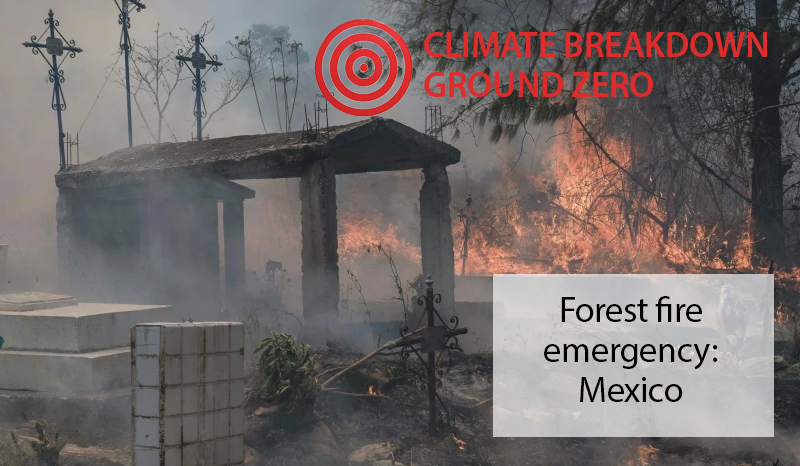
Forest fires were burning in nearly half of Mexico’s drought-stricken states In late March fueled by strong winds and dry conditions. The National Forestry Commission reported 58 active fires in 15 states, including in protected nature reserves in Morelos, Veracruz and Mexico states.
A preliminary estimate of the affected area reached more than 3,500 acres.
While Mexico’s brutal heat wave has been linked to the deaths of at least 26 people since March, veterinarians and rescuers say it has killed dozens and perhaps hundreds of howler monkeys. Around a third of the country saw highs of 45 degrees Celsius (113 degrees Fahrenheit) on Tuesday.
CO2 | CH4 levels increasing rapidly, hit new threshold
Highest level in millions of years
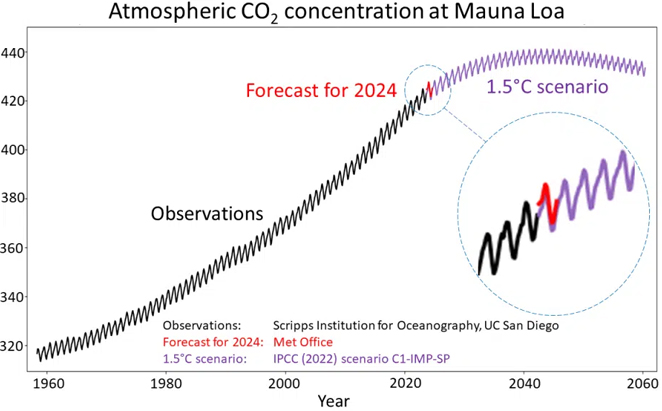
The Mauna Loa Observatory, Hawaii atmospheric CO2 readings hit a high of 423.6 ppm, which is d 2.84 parts per million (ppm) higher than 2023. The level crossed the 425 mark for the first time in February.
The rate of emissions increase varies from year, as does the ability of planetary carbon sinks to absorb them, but the message that fails to get reported is that CO2 doesn’t go away in the atmosphere. Whatever little games humans are playing with our commitments, the actual quantity of GHGs continues to increase.
Energy companies operating in countries such as the US, UK, Germany and Norway appear to have installed technology that could stop researchers from identifying methane, carbon dioxide emissions and pollutants at industrial facilities involved in the disposal of unprofitable natural gas, known in the industry as flaring.
Flares are used by fossil fuel companies when capturing the natural gas would cost more than they can make by selling it. They release carbon dioxide and toxic pollutants when they burn as well as cancer-causing chemicals.
Methane (CH4) levels are even more frightening, as new sources of the powerful gas are discovered. Methane is about 30 times more dangerous than CO2, although it doesn’t remain in the atmosphere as long.
Rising CO2 levels are driving horrific changes to the global environment, amplifying extreme weather events such as heatwaves, floods, droughts, and wildfires and contributing to unprecedented oceans temperatures.
These levels are the highest in millions of years.
3.2 million Americans exit climate abandonment areas
Hidden climate refugees in America
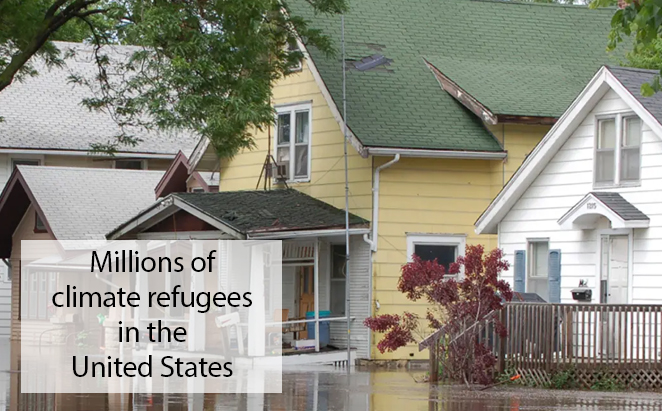
Research published in Nature-Communications highlights the emergence of “Climate Abandonment Areas”, which are locations that have lost population from 2000 – 2020 and can be directly attributed to climate change related flood risk.
According to the analysis, 113 million people already live in areas where flood risk impacts housing availability. These Climate Abandonment Areas saw a cumulative net loss of over 3.2 million in population between the years of 2000 and 2020. The migration is directly attributed to flooding.
Future implications of this trend are significant, and impact property values, neighborhood composition, and commercial viability both positively and negatively”.
Relentless Catalonia drought hitting sparkling wine grapes
Cava wine maker makes massive worker cuts
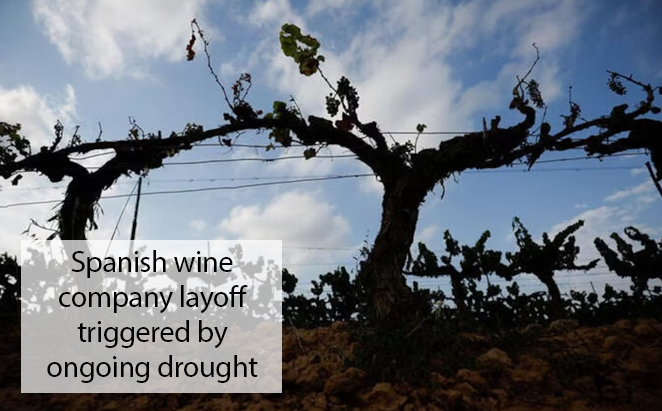
Winemaker Freixenet is laying off 80% of its Catalonian workforce due to an extended drought that is seriously compromising cava grapes. The extended lack of rain is having a serious effect on the harvest, threatening production of Spain’s sparkling wine.
Water shortages began in 2021 but began to really kick in last years.
Wildfires in Venezuela driven by historic drought
Rainforest exploitation and global warming
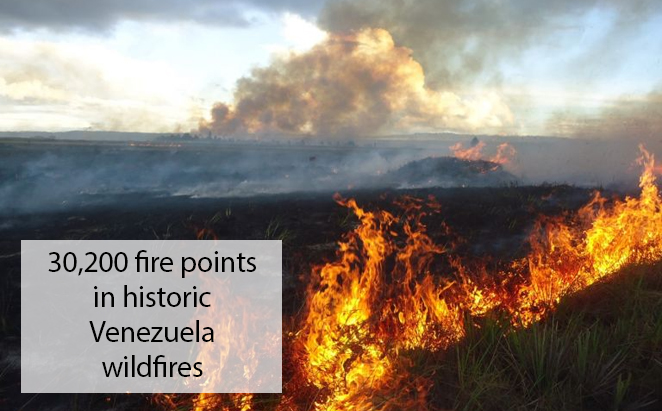
Venezuela is battling a record number of wildfires, as a climate-driven drought plagues the Amazon rainforest region.
Satellites registered more than 30,200 fire points in the region from January to March, the highest level for that period since records started in 1999, according to Brazil’s Inpe research agency, which monitors all of South America.
Human-made fires for land clearing are spreading out of control because of high temperatures and low rainfall in northern South America. Unenlightened land use policies are exacerbating the situation.
“Everything is indicating we’re going to see other events of catastrophic fires — megafires that are huge in size and height.”
110,000 evacuated in historic China storms and flooding
Extreme weather increasing in China
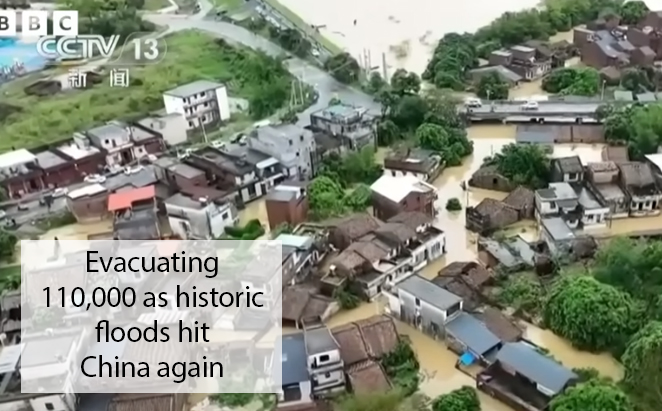
Four people are dead and more are missing as yet another killer storm system generates floods in southern China. Footage from across Guangdong province showed flooded villages, farmland and cities, along with collapsed bridges and floating vehicles. In addition to the 110,000 people who have been evacuated, at least 25,000 are in emergency shelters.
Authorities have registered cumulative rainfall of 24 in. in April, the highest monthly volume since record-keeping began in 1959.
The sustained torrent impacted the Pearl River Delta region, a manufacturing hub and one of the country’s most populated regions for close to a week.
The regions usually gets the heavy rains in September, but has been experiencing more intense and more frequent rainstorms and floods in recent years.
Bogota rationing water as reservoir level plunge
Meanwhile, floods and hail
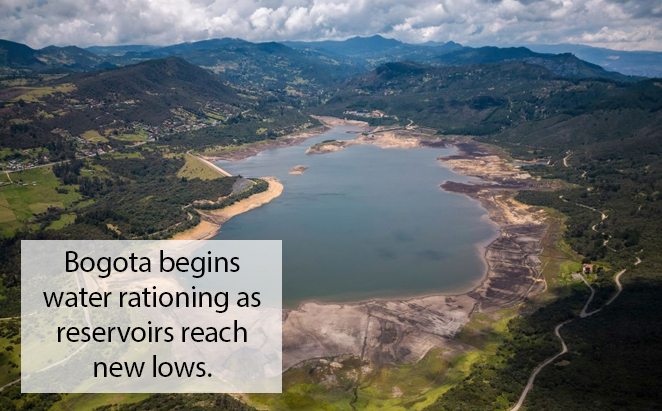
The Colombian government has announced water rationing as local reservoirs reach historically low levels. The emergency plans was implemented due a lack of rain and extreme temperatures.
In an emerging pattern defining the new normal, drought and land exploitation combine to create historic fire catastrophe potential.
Madagascar suffers continuing megadrought and famine
Another new normal for southern island
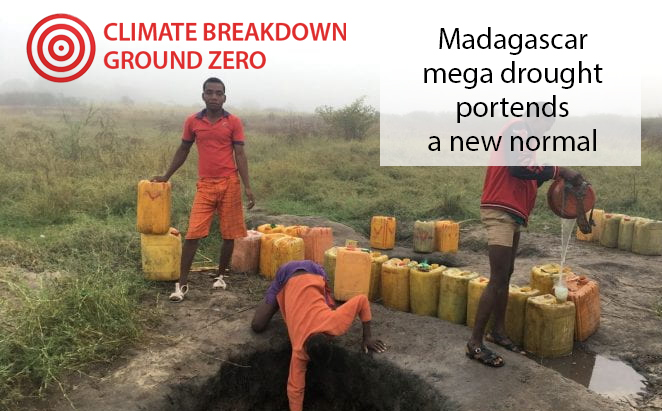
In a new study published in Nature’s Climate and Atmospheric Science, University of California, Irvine-led research points to a link between human-driven climate change and the years-long drought currently gripping southern Madagascar.
The United Nations first declared southern Madagascar in a state of famine beginning in 2021.
“Our study shows that this phenomenon is entirely driven by climate change. The picture is that this is going to be recurrent into the future.”
Bangalore, running out of H2O in India’s “silicon valley”
Combination of climate and human causes
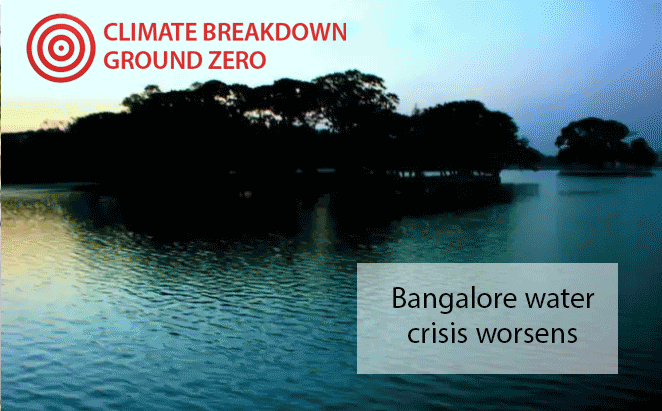
India’s high tech silicon valley finds itself in an extended water crisis that appears to be the worst yet. The situation is related to the disappearance of the mega city’s once numerous lakes, which have dried up and become increasingly toxic in the process.
According to the latest report, more than 800 lakes in the Bengaluru Urban district have disappeared, with 80% of the remaining lakes are polluted and unsuitable for any use.
The crisis is the result of warming, over-extraction and pollution.
Drought flood drought pattern threatens southern Africa
Meanwhile, floods and hail
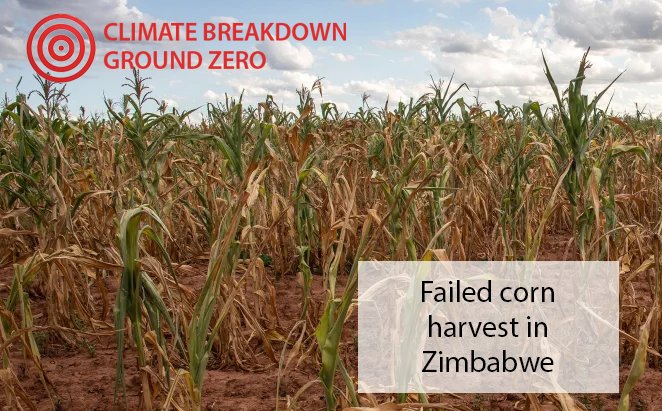
Extended drought combined with catastrophic floods is causing hunger, malnutrition and water scarcity for 24 million people in southern Africa nations, including Zimbabwe, Zambia and Malawi. All of these countries have declared national disasters.
Aid workers on the ground are calling it an “unimaginable humanitarian situation.”
Dengue fever expands globally as mosquito range increases
Another new normal for southern island
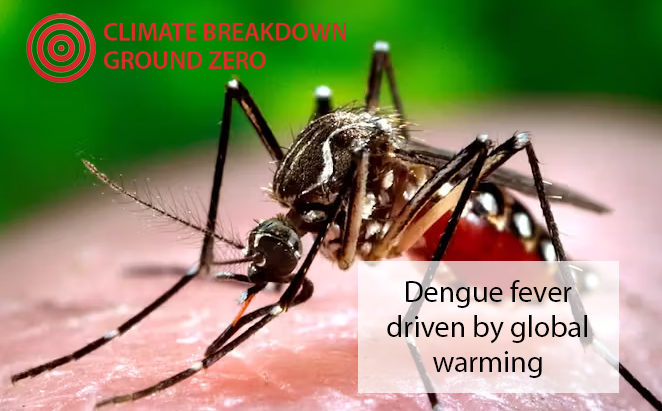
Warmer temperatures, intensifying storms,, more erratic and frequent rainfall is causing outbreaks of mosquito-borne illnesses around the world. Over the past two decades, many regions of the world have become more hospitable to the Aedes genus of mosquito. Warmer winters, hotter summers, and milder springs and falls allow mosquitoes to move into warming regions and higher elevations
Puerto Rico declared a public health emergency this week as cases of dengue fever increase rapidly on the US island s territory as record 549 cases have been reported already this year so far, a 140 percent increase over the same period a year ago.
Puerto Rico’s health department is the latest government agency to mobilize its public health resources in service of controlling and treating large outbreaks of dengue. Bangladesh and Sri Lanka tried to tamp down unprecedented rates of dengue infections in the last year with varying degrees of success. Vast portions of Central and South America are battling months-long, record-breaking dengue crises. Some 5 million cases of the infection were reported worldwide in 2023, and the disease continues to spread. Already, an estimated 3.5 million cases of the infection and 1,000 deaths have been reported across the Americas in 2024 thus far — a rate of infection health officials predict will lead to a record-breaking number of dengue cases this year.
Russia floods driven by unprecedented snow melt
Combination of climate and human causes
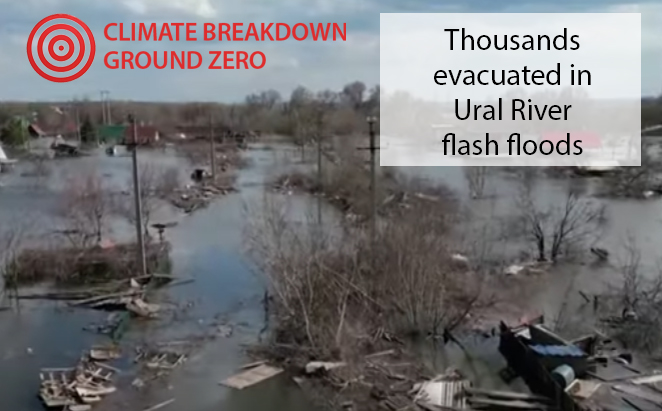
Thousands of Russians have been evacuated after a dam broke in Orenburg, near Kazakhstan. The stress was caused by unprecedented snow melt.
At least three people have died as a result of the flooding and 2,400 homes and apartments were inundated.
